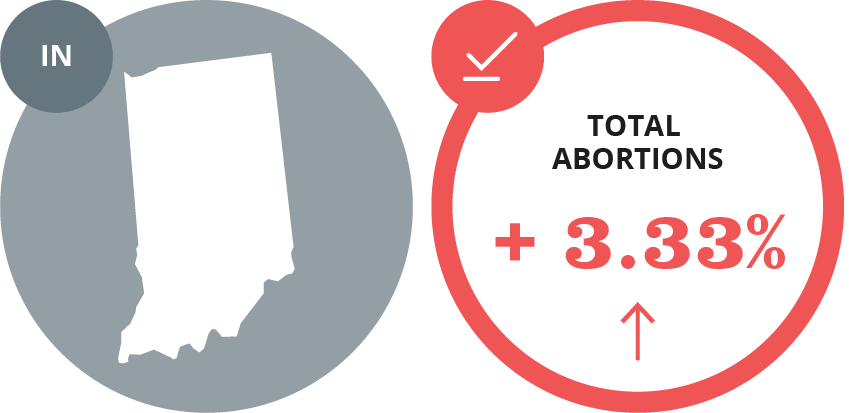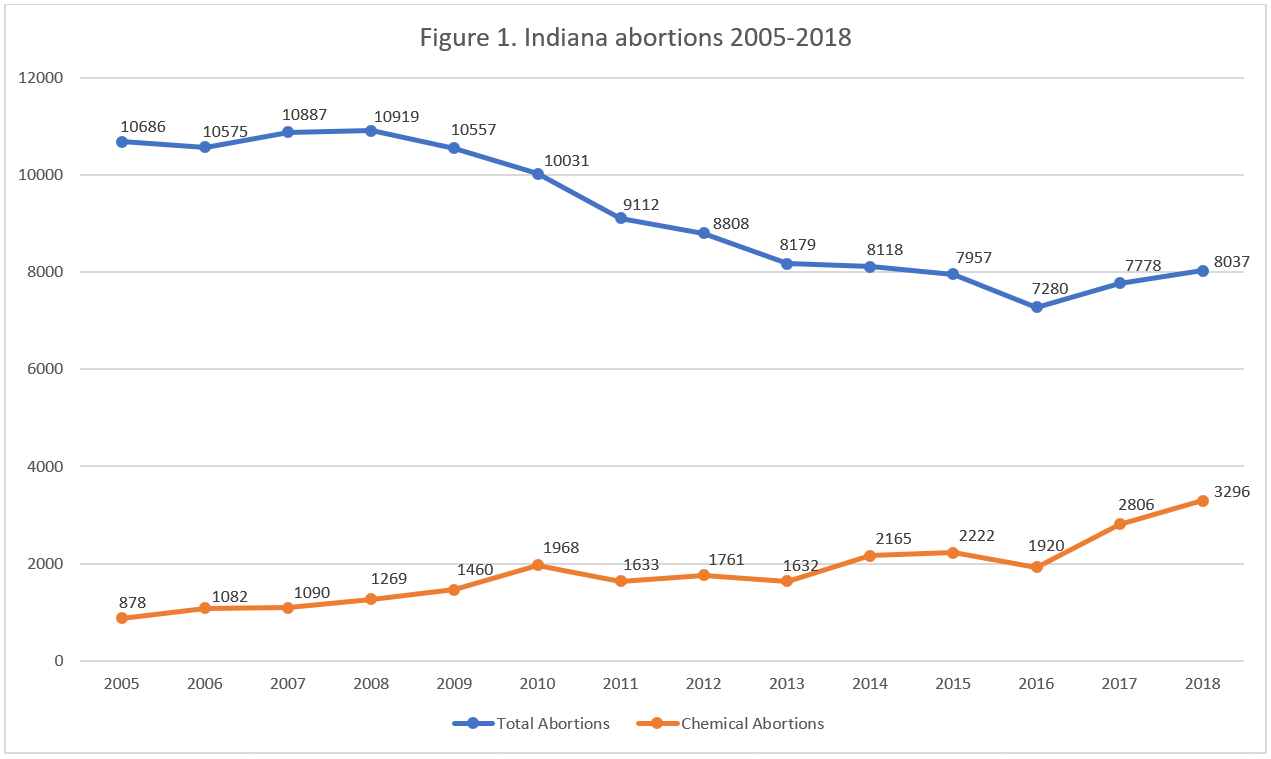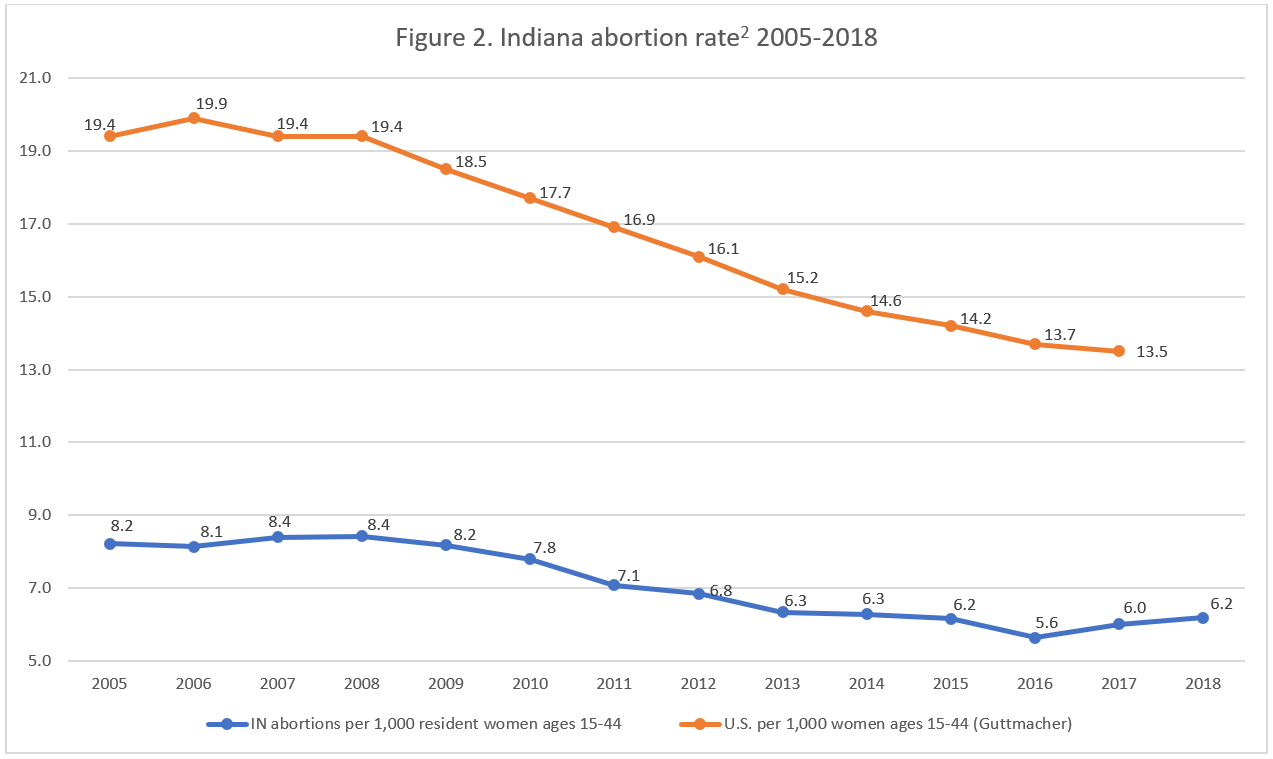Abortion Reporting: Indiana (2018)

Indiana’s 2018 abortion report was published online by the Indiana State Department of Health in July 2019. The report shows that total abortions and the abortion rate in Indiana increased for the second year in a row, a change from its long-term decline.
Statistics and Changes in Indiana Abortions, 2017-2018

Abortion Totals and Trends
There were 8,037 abortions reported in Indiana in 2018, up three percent from the previous year (Fig. 1). Chemical abortions jumped by 17 percent, rising from 2,806 in 2017 to 3,296 in 2018 – the highest it’s ever been in the state (Fig. 1). Since Indiana first reported chemical abortions as a separate category in 2004, chemical abortions have increased by over 700 percent. Total abortions have dropped by 36 percent from 1994. The Charlotte Lozier Institute estimates that Indiana’s state abortion rate in 2018 was 6.2 abortions per 1,000 women in their reproductive years, up from 6.0 the year before but still less than half the national rate (Fig. 2).
State Report Summary
In 2018, 90 percent of Indiana abortions were on state residents, and 10 percent were on nonresident women. Sixty percent of the abortions reported in Indiana were performed on women in their twenties. Twenty-seven percent were in their thirties and 10 percent were in their teens, while just three percent were age 40 or older. Eighty-five percent of the abortions were performed on unmarried women, compared to just 15 percent on married women.
More than half the abortions (55 percent) were performed on white women, and 31 percent were performed on black women. Four percent were performed on Asian women, and just one third of one percent were performed on Pacific Islander and Native Hawaiian women (seven abortions) and American Indian or Alaska Native women (19 abortions). Nine percent of the abortions were performed on women of other races and one percent on women of multiple races. Not quite one percent were performed on women whose race was not reported. Almost nine percent were performed on Hispanic women of any race and 90 percent on non-Hispanic women, while just under two percent were on women of unknown ethnicity.
Nine percent of reported Indiana abortions were on women who had not finished high school. Thirty-six percent were obtained by women who had completed high school and 28 percent by women who had finished some college. A quarter had a college degree, and two percent did not report their level of education.
Many of the women who underwent abortions in Indiana already had children. A quarter had one living child, and 36 percent had two or more. Less than one percent had a child who had died. Thirty-one percent had had an abortion before; 21 percent had one previous abortion, and 10 percent had more than one prior abortion. Eighteen percent had experienced one or more miscarriages.
In 2018, Indiana reported abortions by gestational age using broad gestational ranges (e.g. eight weeks or earlier, nine to 13 weeks, 14 to 20 weeks, and 21 weeks or later), but more specific information was provided to the Charlotte Lozier Institute upon request. Seventeen percent of the abortions reported in Indiana in 2018 occurred at six weeks of gestation or earlier. Forty-one percent were performed between seven and eight weeks, and 24 percent between nine and 10 weeks. Twelve percent of the abortions were performed at the end of the first trimester at 11 to 12 weeks of gestation. An additional five percent occurred between 13 and 15 weeks, early in the second trimester. Fourteen abortions (0.2 percent) were performed between 16 and 19 weeks, and 11 abortions (0.1 percent) were performed between 20 and 21 weeks of gestation. Two abortions were performed at unreported gestational ages, and no abortions were reported after 21 weeks of gestation. Indiana limits abortion after 20 weeks post-fertilization, approximately 22 weeks of gestation, unless the life or physical health of the mother is at risk. Abortions after the first trimester must be performed in a hospital or ambulatory surgical center.
In 2018, 41 percent of the abortions were chemical abortions, and 59 percent were performed using suction curettage. There was one menstrual aspiration abortion and 11 abortions performed with other, unspecified methods. The month of March had the highest number of abortions (824), and the month of July had the lowest (552).
Indiana collects information on abortion complications on its abortion reporting form.1 In 2018, 13 cases of retained products were reported using the abortion reporting form. In addition, there were 68 reported cases where a secondary abortion procedure was needed to complete the abortion. Indiana passed an abortion reporting law in 2018 that required physicians and hospitals to report abortion-related complications they encountered to the state. However, a court order blocked the law from going into effect.
Type of Procedure by Facility
In its 2018 annual report, Indiana reports the types of abortion procedures used at each facility in the state. Ten facilities reported abortions in 2018. Four hospitals together performed 44 abortions, or 0.5 percent of the state total. The Women’s Med Center of Indianapolis performed 1,269 abortions (16 percent) and Clinic for Women performed 1,145 abortions (14 percent). Planned Parenthood’s four Indiana abortion centers – located in Merrillville, Lafayette, Bloomington, and Indianapolis – performed 5,579 abortions, 69 percent of the state total. Planned Parenthood performed 64 percent of the suction curettage procedures reported in Indiana and 78 percent of the chemical abortions reported in the state.
Planned Parenthood has worked to expand chemical abortion in the United States. According to a press release, Planned Parenthood performs telemedicine chemical abortions in 14 states, in which women receive the abortion pills after teleconferencing with a medical provider in a different location. Recently, Planned Parenthood published a study on telemedicine abortions performed by 26 Planned Parenthood centers across four states. The centers performed 6,000 chemical abortions.
State Ranking
In 2016, the Charlotte Lozier Institute conducted a survey of abortion reporting across the country and ranked Indiana’s reporting at 5th best. Since Indiana published its 2017 abortion report in July 2018, the state has improved its reporting by providing information on abortion complications that are reported in the state and by breaking down abortion procedures by facility. Indiana is a transparent state, making data available to researchers and concerned citizens. Indiana could improve its reporting further by noting whether there were any reports of babies born alive during failed abortions, data it already collects, and including information on its informed consent process.


- Statistics on abortion complications reported here represent a minimal number of deaths and complications, as this data is collected in a non-systematic and non-verifiable way. As such, this data cannot be used to calculate either an accurate abortion mortality rate or an accurate abortion complication rate for the state.
- Starting with the 2018 abortion reports, abortion rates are calculated by the Charlotte Lozier Institute to allow for easier state-to-state and year-to-year comparisons. Rates were calculated by CLI using population estimates from the United States Census Bureau. The rates were calculated using the following formula: (total number of abortions performed in Indiana ÷ number of resident women ages 15-44) x 1,000. Rates may differ slightly from previous CLI articles due to revised population estimates.
























